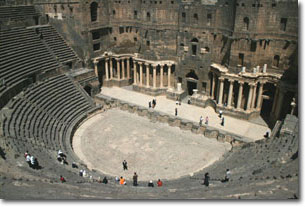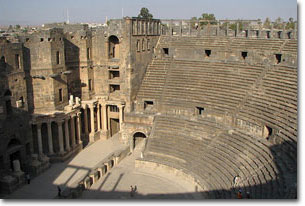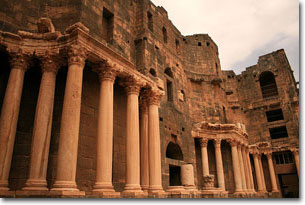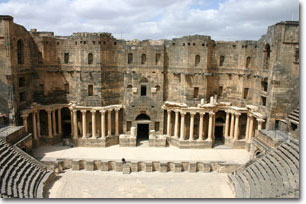|
140 km south of Damascus, to be more specific, south of Suweida we see Bosra, which is, after Palmyra, the most important site of the Roman period in Syria, primarily because of the magnificent and exceptionally intact Roman theatre (early 2nd century AD).

In Roman times, the ecology was different and the Hauran was one of the granaries of the Empire. Its sudden rise to prosperity as the Pax Romana took hold in the first century AD is reflected in the ambitious scale of the civic re-planning later in the century. The town of Bosra, however, had played role in earlier periods. An Early Bronze Age settlement, it is mentioned in Egyptian 18th dynasty records as Bosrana. It became part of the Seleucid domains after Alexander's conquests and was seized by Judas Maccabeus in 163 BC. When the Nabataean Kingdom rose to local prominence in the first century BC, Bosra came within the northern reaches of their control though it was later the object of Herodian ambitions from Palestine. From AD 70 to 106, in the final stages of the Nabataean Kingdom, Bosra was made the capital.
In AD 106 the Romans extended direct rule and established Provincia Arabia, a new province with its headquarters at Bosra. Direct Roman control and the implantation of 5000 legionnaires must have fundamentally altered the Nabataean town. It became heavily influenced in its cultural and civic life by Roman models. Bosra was made the hub of an important network of trade routes linking Egypt/Red Sea/Syria and the Mediterranean/Mesopotamian regions once the more easily traveled country bordering the desert became a safer option.
The city's existing plan was ambitiously expanded. The Nabataean town on the eastern edge of the present ruins was greatly extended by the establishment to the west of a vast new grid which housed the installations and amenities of the Roman administration. Trajan (AD 98 - 117), the creator of the new province, particularly favored the town, renaming it Nova Trajana Bostra. Under Alexander Severus (222 - 235), it was made a full Roman colony. It retained strong imperial patronage through to the reign of Philip the Arab (244 - 9) who was born in the neighborhood, Shahba, and who declared Bosra a metropolis.
It retained its importance through the Christian era of the Later Roman Empire, becoming the seat of an important bishopric. The prophet Mohammed probably visited the city during a trading journey before his religious mission began with the Hijra (immigration) and there are legends of his consulting here a revered Christian monk, Bahira. Bosra lay on the prime access route into Syria from the Arabian desert and was the first Byzantine city to fall to the Arabs in 632 in the opening phase of Islamic expansion.
After the seventh century, the area diminished in agricultural significance as it became prey to political uncertainty. Lying close to Palestine, it was drawn into the long struggle between Crusaders and Arabs, being attacked at least twice (1147 and 1151) by Frankish armies unsuccessfully challenging Nūr al Din's control of the Hauran. The Ayyūbid effort to fortify the theater from 1202 to 1251 only exposed the rest of the area to continued depredations over the centuries not the least of which were the Mongol invasions. The fortress was considerably restored by Baybars in 1261 after the first of these invasions.
The area became neglected agriculturally and by the 19th century it was only lightly inhabited, thus making it ripe for new settlement when many thousands of Druze fled Lebanon during the Druze/Christian struggle of 1840 - 60. The Theater
It is easy enough to distinguish the original fabric from the reconstructed elements added during the restoration. At the beginning of the 20th century, much of the interior of the theater had been filled with sand deposited by the wind over the centuries, a further stroke of good fortune which  accounts for the theater's preservation. After Syria's independence, a of clearance work and research was undertaken lasting from 1947 to 1970. accounts for the theater's preservation. After Syria's independence, a of clearance work and research was undertaken lasting from 1947 to 1970.
The full extent of the theater's seating was revealed with room for 6000 spectators distributed over 2-3000 standing. A voice at normal conversational level rising from the stage can be heard at any point in the theater. The auditorium was probably originally covered with a retractable cloth shading, the stage being protected by a more permanent wooden roof. The fine Corinthian columns give some indication of the richness of the treatment. The three entrances respected the convention of the Roman theater.
The Folklore Museum
Actually the Ayyūbid upper ramparts house the museum, a folklore collection and some carved remains from the Roman period as well as Roman and Arabic inscriptions..
Bosra SyriaThe Roman Baths
 They were laid out in a T-shape with an entrance from the north through an eight-columned porch. This leads to a great domed vestibule, octagonal in shape. The dome, built of volcanic scoria set in hard mortar, has largely collapsed. The vestibule and cold room led into three major chambers furnished with pluming to serve as warm or hot rooms. The baths are probably from the late second or early third century. They were laid out in a T-shape with an entrance from the north through an eight-columned porch. This leads to a great domed vestibule, octagonal in shape. The dome, built of volcanic scoria set in hard mortar, has largely collapsed. The vestibule and cold room led into three major chambers furnished with pluming to serve as warm or hot rooms. The baths are probably from the late second or early third century.
The Monumental Arch
Built in the early third century AD to honor the III Cyrenaica Legion as well as to commemorate Cornelius Palma the Roman Governor of Syria (104 - 108) who oversaw the largely peaceful annexation of the Nabataean Kingdom. The arch follows the traditional pattern of such monuments with the high (13 m) central opening flanked by two smaller arches. |